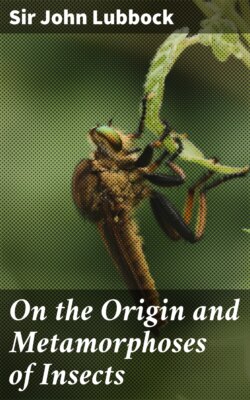Читать книгу On the Origin and Metamorphoses of Insects - Sir John Lubbock - Страница 4
На сайте Литреса книга снята с продажи.
DESCRIPTION OF THE FIGURES.
ОглавлениеTable of Contents
FIG.
1. Larva of the Cockchafer (Melolontha)
2. Larva of Cetonia.
3. Larva of Trox.
4. Larva of Oryctes.
5. Larva of Aphodius.
6. Larva of Lucanus.
7. Larva of Brachytarsus.
8. Larva of Crioceris.
9. Larva of Sitaris humeralis.
10. Larva of Sitaris humeralis, in the second stage.
11. Larva of Sitaris humeralis, in the third stage.
12. Larva of Sitaris humeralis, in the fourth stage.
13. Pupa of Sitaris.
14. Larva of Sirex.
15. Egg of Rhynchites, showing the parasitic larva.
16. The parasitic larva, more magnified.
17. Egg of Platygaster.
18. Egg of Platygaster, showing the central cell.
19. Egg of Platygaster, after the division of the central cell.
20. Egg of Platygaster, more advanced.
21. Egg of Platygaster, more advanced.
22. Egg of Platygaster, showing the rudiment of the embryo.
23. Larva of Platygaster.—mo, mouth; a, antenna; kf, hooked feet; r, toothed process; lfg, lateral process; f, branches of the tail.
24. Larva of another species of Platygaster. (The letters indicate the same parts as in the preceding figure.)
25. Larva of a third species of Platygaster. (The letters indicate the same parts as in the preceding figure.)
26. Larva of Platygaster in the second stage.—mo, mouth; slkf, œsophagus; gsae, supra-œsophagal ganglion; lm, muscles; bsm, nervous system; gagh, rudiments of the reproductive glands.
27. Larva of Platygaster in the third stage.—mo, mouth; ma, mandibles; gsae, supra-œsophagal ganglion; slk, œsophagus; ag, ducts of the salivary glands; bnm, ventral nervous system; sp, salivary glands; msl, stomach; im, imaginal discs; tr, tracheæ; fk, fatty tissue; ed, intestine; ga, rudiments of reproductive organs; ew, wider portion of intestine; ao, posterior opening.
28. Embryo of Polynema.
29. Larva of Polynema.—asch, rudiments of the antennæ; flsch, of the wings; bsch, of the legs; vfg, lateral projections; gsch, rudiments of the ovipositor; fk, fatty tissue.
30. Egg of Phryganea (Mystacides).—A1, mandibular segment; C1-C5, maxillary, labial, and three thoracic segments; D, abdomen.
31. Egg of Phryganea somewhat more advanced.—b, mandibles; c, maxillæ; cfs, rudiments of the three pairs of legs.
32. Egg of Pholcus opilionides, showing the Protozonites.
33. Embryo of Julus.
34. Colony of Bougainvillea fruticosa, natural size, attached to the underside of a piece of floating timber.
35. Portion of the same, more magnified.
36. The Medusa from the same species.
37. Larva of Prawn, Nauplius stage.
38. Larva of Prawn, more advanced, Zoëa stage.
39. Larva of Echino-cidaris œquituberculata seen from above ✕ 6/10.
40. Larva of Echinus ✕ 100.—A, front arm; F, arms of the mouth-process; B, posterior side arm; E1, accessory arm of the mouth-process; a, mouth; a1, œsophagus; b, stomach; b1, intestine; o, posterior orifice; d, ciliated bands; f, ciliated epaulets; c, disc of future Echinus.
41. Comatula rosacea.
42. Larva of Comatula rosacea.
43. Larva of Comatula rosacea, more advanced.
44. Larva of Comatula rosacea, in the Pentacrinus state.
45. Larva of Starfish (Bipinnaria), ✕ 100.
46. Larva of Starfish (Bipinnaria), ✕ 100, seen from the side.—a, mouth; b, œsophagus; c, stomach; c1, intestine.
47. Larva of another Bipinnaria, showing the commencement of the Starfish.—g, canal of the ciliated sac; i, rudiments of tentacles; d, ciliated band.
48. Larva of Moth (Agrotis).
49. Larva of Beetle (Haltica).
50. Larva of Saw-fly (Cimbex).
51. Larva of Julus.
52. Agrotis suffusa.
53. Haltica.
54. Cimbex.
55. Julus.
56. Tardigrade.
57. Larva of Cecidomyia.
58. Lindia torulosa.
59. Prorhynchus stagnalis.
60. Egg of Tardigrade.
61. Egg of Tardigrade, after the yolk has subdivided.
62. Egg of Tardigrade, in the next stage.
63. Egg of Tardigrade, more advanced.
